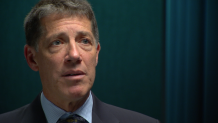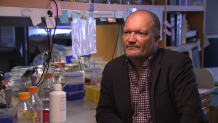A team of international doctors is working to rewrite the clinical guidelines for how and when to medically treat transgender children. The guidelines, which haven’t been updated in nearly a decade, may soon clear a path for earlier medical intervention and layout a comprehensive guide for the future treatment of transgender kids and adults on a global scale, including in the San Francisco Bay Area.
“This is a document that basically covers the age span for transgender individuals,” said Dr. Steve Rosenthal, who is part of the team of physicians working to construct the guidelines that will be released by the Endocrine Society and co-sponsored by the Pediatric Endocrine Society and the World Professional Association of Transgender Health.
“Together, we have worked … to optimize care, both on the mental health side and medical care,” said Rosenthal, who also heads the Child and Adolescent Gender Center at UCSF Children’s Hospital.

Doctors are now considering allowing children to undergo hormone therapy at earlier ages in order to change their bodies. Under current guidelines, that type of treatment is reserved for children 16 and older. However, authors of the new guidelines are considering striking that age requirement so children could begin hormone therapy earlier.
Offering medical intervention at younger ages allows transgender children to physically transform more seamlessly and limit the number of costly and complicated surgeries later in life, according to Rosenthal.
“It makes it a lot easier for that person to blend in,” Rosenthal said. “If you go through female puberty and you have breasts, if you go through male puberty and you have an Adam's apple and a facial male structure, a deepened voice, all of these things are very difficult to change.”
Local
For the first time, authors of the new guidelines are also considering acknowledging the potential benefits of “social transitions” – the process of permitting transgender children to change their names and wardrobes to more closely mirror the gender they identity with, rather than the sex they were assigned at birth. While the current clinical guidelines do not recommend social transitions for children, that could soon change with the upcoming revisions. Under consideration is a recommendation to recognize the possible advantages of social transitions if they are pursued under the consultation of mental health professionals.
“Sure, I’m a kid, but it doesn’t take a genius to realize that I’m not a girl,” said 12-year old Jack, a transgender boy who began socially transitioning last year. The Bay Area 6th grader was born Sophia, but he now identifies as Jack.
“Sophia was there in my head, but Jack was also,” he said. “I see her as a different human being than I am. I’m Jack and Sophia had her own lifetime and I have my own.”

Pausing puberty
Jack recently underwent a medical procedure to have a tiny device implanted in his left arm that pumps medications through the body to stop the effects of puberty.
“It gives them more time to understand who they are without the clock ticking,” said Rosenthal, who has treated Jack and hundreds of other transgender children. “What you are doing is you're basically putting their puberty on hold. You're not promoting the development of either male or female physical characteristics at that point.”
Rosenthal believes halting puberty can lead to an easier and more successful physical transformation for transgender people long term.
“If you intervene with a medication that can put their puberty on pause, after puberty has not progressed too far, you can probably prevent the irreversible physical changes that go along with pubertal development,” Rosenthal said. “This way, a person who is truly transgender doesn't have to face the expense of surgical procedures and the risks.”
Doctors, including Rosenthal, recommend kids get off the puberty blocker by the time they turn 14 for fear of potential side-effects, including the weakening of bones. Once children reach the allowable amount of time on the puberty blockers, they must decide whether to continue the transition process by taking hormones for the rest of their life or stop taking drugs completely to restart their natural puberty process.
Watch: Jack receives 'puberty blocker' implant
'Where is the girl?'
“I think it’s putting a lot on the shoulders of these children,” said Dr. Eric Vilain, a pediatrician and geneticist who heads the Medical Genetics division at UCLA. “It’s putting them on a path that will have a lot of medical and surgical consequences.”
Vilain believes early social transitions unfairly push children to thinking they should identity as the opposite sex. He said these transitions can lead to unnecessary medical interventions for transgender kids.
“People telling me that these boys who behave like girls are in fact girl inside -- I’m saying well, where is the girl?” he asked. “Is their brain different? Are their other genes different? I still have not seen that.”
According to Vilain, physicians are far too willing to recommend social transitions for children. As a result, Vilain believes the vast majority of children currently undergoing social transitions in the U.S. might not actually be transgender and, thus, might not be best served by embracing a sex that doesn't match their gender.
"If the children are pushed in this belief it will be much much harder for them to get out of this belief because everyone will have agreed on it very, very early on," Vilain said. "What worries me is that, indeed, there might be in the upcoming years a considerable number of these children that are placed on a path that we don’t fully know the outcome."

An estimated 1.4 million adults and 150,000 teens in the U.S. identify as transgender. Population figures for younger children, however, are largely unknown. That said, Bay Area gender clinics provide care to more than 550 children, according to data collected by the NBC Bay Area Investigative Unit.
Which kids should transition and when?
While teams of pediatricians and therapists provide ongoing medical and emotional care for transgender children, there is a lack of research detailing which children should transition socially and at what ages.
“We just don’t have definitive data one way or another,” said Dr. Kristina Olson, a research psychologist at the University of Washington who is leading a first-of-its-kind study that aims to provide a treasure-trove of data involving the long-term of trans children.
“To be able to, hopefully, answer which children should or should not transition,” she said.
Olson and her research team are studying 300 trans kids from around the U.S. and Canada and tracking them over the next two decades.

'I’m not completely a girl'
“I’m not completely a girl,” said 7-year-old Maya, who is participating in the study. She was born male, but she began identifying as female as a 3-year-old.
“At first…it’s hard to swallow,” said Meghan, Maya’s mother.
“But really it’s this child’s happiness. I would rather have a transgender daughter than a dead son.”
Megan, like many parents of transgender children, point to studies, including those from the Williams Institute at UCLA, that have shown trans kids are nearly 10 times more likely to commit suicide than non-trans children.
More recently, however, Olson’s research has shown children who were allowed to transition socially are no more depressed and only marginally more anxious than other children, according to data collected from the first three years of her study.
“The kids in our study seem to be doing quite well,” Olson said. “Which is particularly surprising because past work with transgender teens and adults, as well as previous work with gender non-conforming kids had suggested that these kids have very high rates of anxiety and depression.”
The new, international guidelines from the Endocrine Society are expected to lift restrictions on early social transitions and will likely be released by the end of this year.
Transitioning socially is what Jack said ultimately allowed him to feel more comfortable and confident.
“I didn’t feel at home in my body,” he said.
“When I discovered the word ‘transgender,’ I was like ‘huh, maybe this is the missing puzzle piece that I’m missing here.’”
______________________________________
Need to contact our Investigative Unit?
• You can remain anonymous
• 1-888-996-TIPS
______________________________________
Watch the entire series in this NBC Bay Area investigation:



